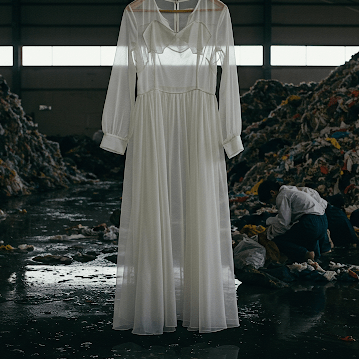The Dark Side of Sheer Fashion:Environmental and Social Costs
That floaty, ethereal blouse. The delicate, barely-there dress. Sheer fashion has undeniably captured our attention, gracing runways and filling our online shopping carts. Its allure lies in its lightness, its suggestion of skin, its ability to transform even the simplest outfit into something a little more daring. But behind the delicate transparency lies a darker truth – a significant environmental and social cost that we, as conscious consumers, need to confront.

The very characteristics that make sheer fabrics so desirable often contribute to their problematic nature. Many popular sheer materials, like polyester chiffon, nylon mesh, and rayon voiles, are derived from fossil fuels or rely on resource-intensive processes.
The Environmental Stain:
- Fossil Fuel Dependence: Polyester and nylon, the backbone of much sheer fashion, are synthetic polymers made from petroleum. Their production contributes to greenhouse gas emissions and our reliance on finite fossil fuel resources.
- Microplastic Mayhem: When these synthetic sheer fabrics are washed, they shed countless microscopic plastic fibers – microplastics – that end up in our waterways and oceans. These tiny pollutants are ingested by marine life, potentially entering the food chain and ultimately impacting human health. The delicate weave of many sheer fabrics can make them particularly prone to shedding.
- Water and Chemical Intensive Production: Even seemingly “natural” sheer options like rayon (often marketed as viscose) come with their own environmental baggage. The production of rayon involves chemically intensive processes that can pollute water sources with harmful substances. The sourcing of the raw material, often wood pulp, can also contribute to deforestation if not managed sustainably.
- Durability Dilemma: The delicate nature of sheer garments often translates to a shorter lifespan. Snags, tears, and the general fragility of these fabrics mean they are more likely to end up in landfills, contributing to textile waste – a growing global crisis.
The Social Threads of Exploitation:
Beyond the environmental impact, the fast-paced nature of sheer fashion trends can exacerbate existing social issues within the garment industry:
- Pressure for Speed and Low Costs: The demand for trendy, affordable sheer garments puts immense pressure on manufacturers to produce quickly and cheaply. This often leads to poor working conditions, long hours, and low wages for garment workers, many of whom are women in developing countries.
- Lack of Transparency: The complex and often opaque supply chains of the fashion industry make it difficult to trace the origins of fabrics and ensure ethical labor practices are being followed. This lack of transparency allows exploitation to thrive.
- Disposable Culture: The fleeting nature of trends, including sheer styles, encourages a culture of disposability. We buy, wear a few times, and then discard, further fueling the cycle of environmental and social harm.
Peeking Through the Illusion: What Can We Do?
The allure of sheer fashion doesn’t have to come at such a steep cost. As conscious consumers, we have the power to demand better:
- Choose Mindfully: Opt for sheer garments made from more sustainable materials like organic cotton voile, silk (sourced ethically), or innovative recycled options. Look for certifications that indicate responsible production.
- Invest in Quality: Choose well-made sheer pieces that are designed to last, even if they come with a slightly higher price tag. Proper care can significantly extend their lifespan.
- Embrace Second-hand: Explore vintage and consignment stores for unique and pre-loved sheer finds.
- Care Consciously: Wash delicate sheer items by hand or in a gentle cycle with a Guppyfriend washing bag to capture microplastics. Air dry whenever possible.
- Demand Transparency: Support brands that are transparent about their supply chains and committed to ethical and sustainable practices. Ask questions and hold them accountable.
- Challenge Trends: Resist the urge to constantly buy into fleeting trends. Embrace a more timeless and considered approach to your wardrobe.
Sheer fashion, in its most responsible form, can still be beautiful and expressive. By understanding the “dark side” and making more conscious choices, we can push the industry towards greater transparency and sustainability, ensuring that our desire for delicate beauty doesn’t come at the expense of our planet and its people. Let’s choose to see through the illusion and demand a more ethical and environmentally sound future for our wardrobes.
